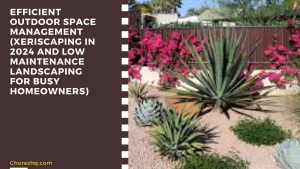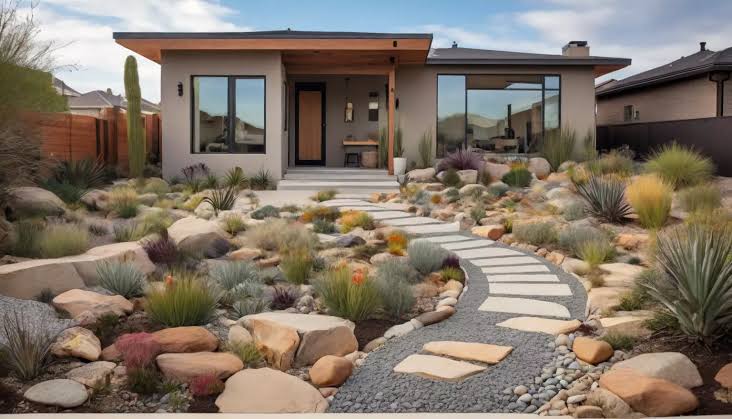Efficient Outdoor Space Management (Xeriscaping In 2024 And Low Maintenance Landscaping For Busy Homeowners

Discover the latest in efficient outdoor space management for 2024 with a focus on xeriscaping and low-maintenance landscaping. Learn how busy homeowners can benefit from cost savings, time efficiency, and environmental advantages through sustainable landscaping practices. Explore trends, innovative materials, and practical strategies to create beautiful, low-maintenance gardens that thrive in any climate. Unveil the potential of drought-resistant plants and hardscaping elements to transform your outdoor space into a vibrant, eco-friendly haven. Embrace the future of gardening with these expert insights and tips designed for modern homeowners.
Introduction
Efficient outdoor space management is becoming increasingly relevant in 2024, with homeowners seeking practical solutions to enjoy their gardens without extensive upkeep. Key strategies such as xeriscaping and low-maintenance landscaping are at the forefront of this trend.
Xeriscaping
This strategy involves designing landscapes that require minimal water, utilizing drought-resistant plants and innovative gardening techniques. This method significantly reduces irrigation needs while promoting environmental sustainability.
Low-Maintenance Landscaping
On the other hand, this approach focuses on creating beautiful spaces that demand less time and effort for upkeep. Busy homeowners benefit from:
- Cost savings: Reduced water bills and lower maintenance expenses.
- Time efficiency: Less time spent on garden chores.
- Environmental advantages: Enhanced biodiversity and decreased reliance on chemical treatments.
Adopting these practices allows you to maintain an attractive outdoor space with minimal resources, aligning perfectly with modern sustainable living principles.
Understanding Xeriscaping: A Sustainable Approach to Outdoor Space Management
Xeriscaping is a landscaping method specifically designed to minimize water usage, making it an excellent choice for sustainable gardening. At its core, xeriscaping focuses on using drought-resistant plants and innovative gardening techniques to create beautiful, low-water landscapes. The term “xeriscape” comes from the Greek word “xeros,” meaning dry, which reflects its emphasis on water conservation.
Principles of Xeriscaping
The primary principles of xeriscaping include:
- Planning and Design: Careful planning helps in selecting plants and designing layouts that maximize water efficiency.
- Soil Improvement: Enhancing soil health ensures better water retention.
- Efficient Irrigation Systems: Utilizing drip irrigation or soaker hoses to minimize water loss.
- Mulch Application: Applying mulch reduces evaporation and controls weed growth.
- Appropriate Plant Selection: Choosing plants that are native or well-adapted to the local climate.
- Practical Turf Areas: Limiting grassy areas that require extensive watering.
- Regular Maintenance: Performing minimal but effective maintenance tasks like pruning and weeding.
Historical Context
Xeriscaping has evolved significantly over the years. Initially developed during the 1980s in response to prolonged droughts, it has become increasingly relevant in regions like California, where water scarcity is a persistent issue. The practice gained momentum due to its ability to drastically reduce irrigation needs while maintaining aesthetic appeal.
Role of Drought-Resistant Plants
Drought-resistant plants play a crucial role in xeriscaping by promoting water conservation. These plants have adapted to survive with minimal water, making them ideal for arid regions. Examples include:
- Succulents: Such as Aloe Vera and Agave
- Native Grasses: Like Buffalo Grass
- Flowering Plants: Including Lavender and Yarrow
Using these plants not only conserves water but also supports local ecosystems by providing habitats for native wildlife.
Incorporating these elements into your landscaping strategy can lead to significant environmental benefits while reducing your garden’s reliance on extensive watering and chemical treatments.
Benefits of Xeriscaping for Busy Homeowners
Water Savings
Adopting xeriscaping can lead to significant water savings. Studies indicate the potential for a 50-75% reduction in irrigation needs compared to traditional landscaping methods. This substantial decrease not only conserves a vital resource but also translates into lower water bills, providing cost savings over time.
Reduced Maintenance Efforts
The design principles of xeriscaping inherently demand less upkeep. Drought-resistant plants require minimal watering and are typically more resilient to pests and diseases. This makes xeriscaped gardens perfect for those with tight schedules or limited gardening expertise.
- Lower maintenance costs: Less frequent watering and reduced need for chemical treatments result in lower ongoing expenses.
- Time efficiency: Homeowners spend less time on tasks such as mowing, weeding, and watering.
Environmental Benefits
Xeriscaping supports environmental sustainability by enhancing biodiversity and reducing chemical usage:
- Enhanced biodiversity: Native and drought-tolerant plants often attract local wildlife, including pollinators like bees and butterflies.
- Reduced reliance on chemical fertilizers and pesticides: Xeriscaped gardens typically need fewer chemicals, promoting healthier soil ecosystems.
By integrating these elements into your landscape, you can enjoy a beautiful, low-maintenance garden that aligns with eco-friendly practices while saving both time and money.
2024 Trends in Low-Maintenance Landscaping: Creating Beautiful Spaces with Minimal Effort
Low-maintenance landscaping trends in 2024 focus on creating visually appealing outdoor spaces with minimal effort. By adopting innovative materials and design strategies, busy homeowners can achieve efficient outdoor space management.
Innovative Materials for Reduced Lawn Areas
Gravel and Mulch
These materials are increasingly popular for minimizing traditional lawn areas. Gravel paths and mulch beds not only reduce the need for watering but also add texture and visual interest to your garden.
Synthetic Turf
For those who crave the look of a green lawn without the upkeep, synthetic turf offers a realistic alternative that requires no mowing or irrigation.
Regionally Thriving Plants
Selecting plants that thrive in your local climate is essential for reducing maintenance. These plants are naturally adapted to local conditions, requiring less water and care.
Drought-Resistant Species
In arid regions, succulents, cacti, and native grasses are ideal choices.
Local Perennials
These plants come back year after year without needing replanting, saving you both time and money.
Incorporating Hardscaping Elements into Your Landscape Design Strategy
Hardscaping features play a crucial role in low-maintenance landscaping by reducing the need for ongoing plant care while enhancing the aesthetic appeal of outdoor spaces.
Patios and Decks
Create functional outdoor living areas that require little maintenance.
Pathways
Use stone, brick, or concrete pathways to connect different parts of your garden. They help control foot traffic and reduce wear on plant beds.
Retaining Walls
These structures can manage soil erosion while adding tiered planting areas for additional visual interest.
Examples of Effective Hardscaping Elements
- Rock gardens: Combine various sizes of rocks with drought-tolerant plants to create a low-maintenance yet striking landscape feature.
- Water features: Incorporate fountains or small ponds using recirculating water systems to add a soothing element without significant water consumption.
By integrating these trends into your landscape design strategy, you can create beautiful, sustainable outdoor spaces with minimal effort.
Key Strategies for Efficient Outdoor Space Management in 2024: From Plant Selection to Innovative Techniques
Importance of Choosing Native Plant Species
Choosing native plant species is essential for efficient outdoor space management. These plants are crucial due to their adaptability to local climates, requiring less water and maintenance. This makes them ideal for xeriscaping and low-maintenance landscaping. Here are some benefits of incorporating native plants into your garden:
- Water-saving capabilities: Native species have naturally evolved to thrive in local conditions, meaning they often need less irrigation.
- Support for local wildlife: Native plants provide habitat and food sources for indigenous fauna, promoting biodiversity.
Benefits of Ornamental Grasses
Ornamental grasses offer a blend of aesthetic appeal and practical advantages:
- Visual appeal: These grasses come in various colors, textures, and sizes, adding dynamic visual interest to any landscape.
- Low-maintenance: Once established, ornamental grasses are drought-resistant and require minimal care. They are perfect for busy homeowners who want a beautiful garden without the hassle.
Interestingly, there are also native grass options that can serve as both ornamental and functional elements in your garden.
Ground Cover Plants: Nature’s Solution for Maintenance Reduction and Weed Control
Ground cover plants like creeping thyme or sedum play a significant role in reducing maintenance needs:
- Weed suppression: These plants spread across the soil surface, filling gaps and preventing weeds from taking root.
- Soil health improvement: Ground cover plants help retain soil moisture and reduce erosion.
These ground cover options can be seamlessly integrated into xeriscapes or low-maintenance gardens. They offer an effective solution for creating lush landscapes that require minimal effort to maintain.
Exploring alternative lawn options could also complement your outdoor space management strategy by introducing lower maintenance alternatives to traditional lawns.
Efficient outdoor space management in 2024 leverages the strengths of native plants, ornamental grasses, and ground cover species. By focusing on these elements, you can create a sustainable, visually appealing garden that thrives with minimal intervention.
Visual Appeal in Xeriscaping Design: Beyond Cacti and Rocks
Many people think xeriscapes are dull or unattractive. But the truth is, xeriscaping can be full of bright colors and interesting textures if you choose your plants carefully.
Vibrant Colors and Textures
- Flowering Plants: Use drought-resistant flowers like lavender, yarrow, and penstemon to add pops of color.
- Ornamental Grasses: Include grasses such as blue fescue or feather reed grass for texture and movement.
- Succulents: Make your garden more interesting with succulents like agave or echeveria, which come in many shapes and colors.
Techniques for Soil Health
- Mulching: Use organic mulch to keep moisture in and improve soil structure.
- Composting: Add compost to your soil to increase nutrients and support plant health.
- Soil Testing: Regularly check your soil so you can make adjustments that help your garden thrive.
The secret to a beautiful xeriscape is blending these elements together. By carefully mixing plants, hardscapes, and soil treatments, you can create a stunning landscape that needs little water and maintenance. This approach not only enhances the visual appeal but also promotes sustainable practices, much like the principles outlined in this xeriscaping blog which emphasizes on creating beautiful yet water-efficient landscapes. Additionally, for those looking for detailed guidelines on maintaining a California-friendly landscape, the Be Water Wise maintenance book offers valuable insights.

FAQ On Xeriscaping
What is xeriscaping?
Xeriscaping is a landscaping method designed to reduce or eliminate the need for irrigation by using drought-resistant plants and innovative gardening techniques.
Is xeriscaping only suitable for arid regions?
While xeriscaping is particularly beneficial in arid and semi-arid climates, its principles can be applied in various environments to promote water conservation and reduce maintenance.
What types of plants are used in xeriscaping?
Typical plants include native species, succulents, ornamental grasses, and other drought-tolerant varieties. Examples are lavender, sage, yucca, and sedum.
How much water can I save with xeriscaping?
Studies show potential water savings of 50-75% compared to traditional landscaping methods.
Does xeriscaping require special soil preparation?
Improving soil health through the addition of organic matter and appropriate mulching practices enhances plant growth and water retention.
Can xeriscaped gardens be visually appealing?
Absolutely. By incorporating a variety of flowering plants, grasses, and non-plant elements like stones and gravel, you can create vibrant and diverse landscapes.
How do I start a xeriscaping project?
Begin by assessing your yard’s conditions (soil type, sunlight exposure), selecting appropriate plants, and designing a layout that maximizes water efficiency. Consulting with a landscaping professional may also be beneficial.
Is maintenance completely eliminated with xeriscaping?
While maintenance is significantly reduced, some upkeep such as occasional watering during extreme droughts, pruning, and checking for pests will still be necessary.
Conclusion
Using efficient outdoor space management approaches like xeriscaping or low-maintenance landscaping has many benefits. Busy homeowners can significantly reduce their water usage, resulting in lower utility bills and a more sustainable lifestyle. The time saved on garden maintenance can be redirected towards other important activities, making these methods highly practical.
Sustainable landscaping solutions also contribute to environmental conservation. By choosing drought-resistant plants and minimizing the use of chemical fertilizers, you promote biodiversity and healthier ecosystems. These practices not only benefit your immediate surroundings but also support broader ecological balance.
